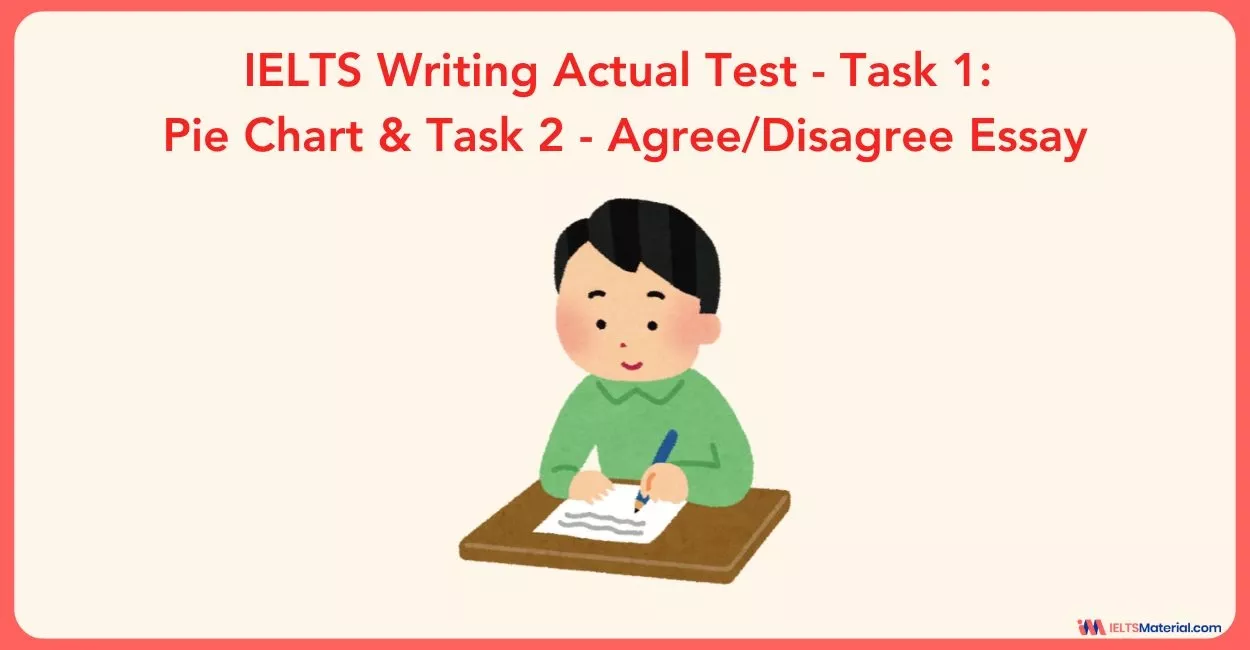IELTS Writing Actual Test - Task 1: Pie Chart & Task 2 - Agree/Disagree Essay
Get set to answer this IELTS Writing Actual Test - Task 1: Pie Chart & Task 2 - Agree/Disagree Essay. Find out the ways to answer the question types with our expert tricks as well to achieve a Band 7.0–8.0 score!
Table of Contents
- Tricks to Frame a Band 9 IELTS Pie Chart Report
- IELTS Writing Task 1 - Pie Chart
- IELTS Writing Task 1 Pie Chart - Band 8 Sample Answer
- IELTS Writing Task 2 - Agree/Disagree Essay
- Question
- Structure Breakdown for the Agree/Disagree Essay
- IELTS Writing Task 2 Agree/Disagree Essay - Band 8 Sample Answer

Try AI Essay Checker for Instant Band Score
In the IELTS Writing tasks you are assessed by not only your English proficiency but also your ability to present ideas logically, compare data, and provide well-structured arguments.
In this article, let us get ready to explore the IELTS Writing practice test, which includes Task 1 (Pie chart) and Task 2 (agree or disagree essay). Alongside sample answers, we will also share useful topic-specific tips to help you improve your band score.
Tricks to Frame a Band 9 IELTS Pie Chart Report
Introduction
- Begin by paraphrasing the given task statement. This means to start restating the given information in your own words without ever changing the meaning.
- For example, if the question says “The pie charts show the percentage of household spending in 2001 and 2020,” you could write “The diagrams show how the household expenditure was distributed across various categories in the years 2001 and 2020.”
Overview
- The overview is one of the most important parts of your answer. In this, you should be highlighting the main features of the given pie chart rather than explaining the details.
- Try mentioning the largest and smallest categories, any important differences, or overall changes if more than a single chart is presented.
- For example, you can say, “In an overall view, housing and food showed the largest shares, whereas the entertainment part consistently accounted for the smallest proportion.”
Body Paragraphs
- Separate your details properly into two clear paragraphs.
- In the first body paragraph, try to describe the major categories (the largest parts or those that are standing out the most).
- Use the approximate figures or percentages if necessary, but try to avoid listing all numbers.
- In the next body paragraph, focus on the smaller categories and try to make comparisons where relevant. This balance makes sure that you cover all aspects of the given data without overwhelming the examiner.
Language Use
- Try using a wide range of expressions to describe percentages and comparisons.
- Instead of consistently repeating “percent,” you can vary your language with terms like “accounted for,” “represented,” or “comprised.”
- For comparisons, try using expressions such as “was twice as large as,” “slightly lower than,” or “just under.”
- This variety in language showcases strong vocabulary skills, which the examiners look out for in an ideal candidate.
Final Tips
- Do not try to describe every single percentage given.
- Focus on the given trends and relationships between the given categories.
- Aim for writing around 150–170 words to keep your writing concise yet specific enough.
- Always make sure to include an overview, because without it your band score for Task Achievement will be limited.
IELTS Writing Task 1 - Pie Chart
You should spend no more than 40 minutes on this task.
The charts show the Australian school leavers did immediately after leaving secondary school. Summarise the information by selecting and reporting the main features, and make comparisons where relevant.
You should write at least 250 words.
IELTS Writing Task 1 Pie Chart - Band 8 Sample Answer
The given pie charts give information about what Australian students decided to do after graduating from secondary school in 1980, 1990, and 2000.
Overall, throughout the years the proportion of this group of Australian students who were employed was growing, while there was a decline in the portion of those pursuing higher levels of education.
In 1980, half of Australian secondary school leavers wanted to advance their scholastic achievements. After a 10-year period, this number plunged to only 38% and remained nearly unchanged in 2000. Meanwhile, the figure for those who failed to seek employment in the country was smallest, at only 10% in 1980 and 12% in 1990. It finally experienced a mild decrease to 8% in 2000.
On the other hand, Australia saw an increase in the percentage of students who had a job after graduation from secondary school, from 40% in 1980 to 55% in 2000, which was the largest among all of the examined categories.
Get set to enhance your IELTS Writing game with our best experts now! Book a FREE Demo!
IELTS Writing Task 2 - Agree/Disagree Essay
Question
You should spend 40 minutes on this task.
The young today spend a large amount of their leisure time in shopping centres. It is feared that this trend can bring negative influences on the youths and the society. To what extent do you agree or disagree with this view?
You should write at least 250 words.
Structure Breakdown for the Agree/Disagree Essay
|
Type of Essay:
Structure Breakdown: Introduction
Main Body Paragraph 1
Main Body Paragraph 2
Conclusion
|
IELTS Writing Task 2 Agree/Disagree Essay - Band 8 Sample Answer
The young today spend a large amount of their leisure time in shopping centers. It is feared that this trend can bring negative influences on the youths and the society. I strongly agree with this view.
On the individual level, allocating excessive amounts of lime on making purchases at shopping malls can make the young generations waste a great deal of money. Although browsing for products like clothes or perfumes can be a captivating experience, the youths are easily tempted into impulsive buying as there are dozens of brands with various prices and designs for them to choose from. A clear example is a fashionable girl buying 10 shirts and jeans in a row because there is a big sale period in progress at Christmas Holiday and this costs her somewhere 100 dollars, quite a high sum of money. In addition, such items often end up being unused: some dresses can be left in the wardrobe, covered with dust anti are unfortunately over-sized upon people’s first use.
On the societal level, the communities can suffer from a decrease in the intellectual level and work productivity as young people are more interested in
leisure pursuits rather than focusing on their work or study. It is undeniable that an average woman spends at least two hours doing the shopping while shopaholics can spend a whole day, and the trend is that they are being more and more willing to spend fewer hours at the workplace during weekdays, or students often stop reading a book and head to the nearest shopping mall if their friends ask them out. Gradually, the economy also suffers due to less work being done, and the youths could slack off in their acquisition of knowledge, making the national education standard drop significantly.
In conclusion, I believe that this trend has an overall negative impact on both the young and the society as a whole.
Also check :
Explore IELTS Writing

Start Preparing for IELTS: Get Your 10-Day Study Plan Today!
Recent Articles
Haniya Yashfeen

Kasturika Samanta






Post your Comments
1 Comment